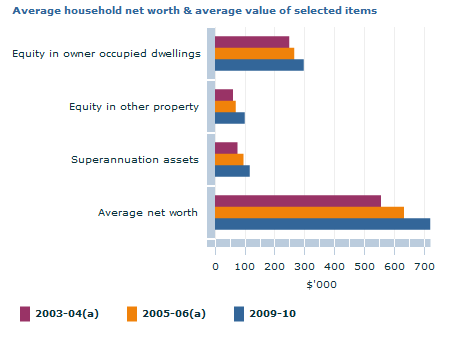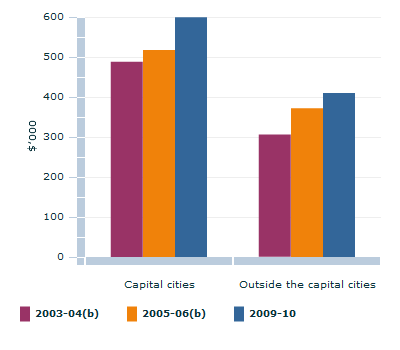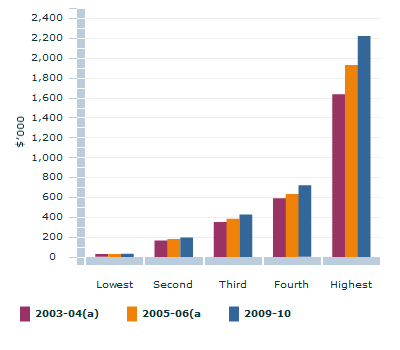Page tools:
 Print Page Print Page
 Print All Print All
| |||||||||||||||||||||||||||||||||||||||||||||||||||||||||||||||||||||||||||||||||||||||||||||||||||||||||||||||||||||||||||||||||||||||||||||||||||||||||||||||||||||||||||||||||||||||||||||||||||||||||||||||||||||||||||||||||||||||||||||||||||||||||||||||||||||||||||||||||||||||||||||||||||||||||||||||||||||||||||||||||||||||||||||||||||||||||||||||||||||||||||||||||||||||||||||||||||||||||||||||||||||||||||||||||||||||||||||||||||||||||||||||||||||||||||||||||||
CONTENTS Article Introduction Levels of household wealth Home ownership Superannuation Other property Contents of dwelling Own incorporated businesses Accounts with financial institutions Own unincorporated businesses Shares Trusts Vehicles Liabilities Distribution of household wealth Looking ahead Explanatory Information Data sources and definitions Endnotes  Footnote(s): (a) In 2009–10 dollars, adjusted using changes in the Consumer Price Index Source(s): ABS Survey of Income and Housing; ABS Consumer Price Index, Australia, June Quarter 2011 (cat. no. 6401.0) INTRODUCTION The economic wellbeing of individuals is largely determined by their command over economic resources. People's income and wealth provide access to many of the goods and services consumed in daily life. Reserves of wealth can be used to support current consumption and to smooth consumption over people's lifetimes. Over recent decades, successive Australian governments have actively encouraged the accumulation of superannuation wealth, maintained negative gearing tax incentives for investment, maintained the tax free status of capital gains on the family home, and financially assisted first home buyers. Such policies aim to smooth levels of consumption over the life course, build wealth during pre-retirement years and help people fund their retirement living. LEVELS OF HOUSEHOLD WEALTH In 2009-10, on average, households in Australia held assets valued at $839,000, partially offset by average household liabilities of $120,000. After adjusting for changes in the CPI, the average household net worth of $720,000 in 2009-10 was 14% higher than in 2005-06, and 30% higher than in 2003-04. Net equity in home ownership in 2009-10 averaged $297,000 across all households in Australia, and accounted for 41% of total household wealth. Superannuation was the next largest component of household wealth, averaging $116,000, followed by property other than the family home ($100,000). HOME OWNERSHIP The increased value of households' equity in their own homes accounted for nearly a third of the 30% real increase in average household wealth between 2003-04 and 2009-10. The contribution that rising home equity values made to wealth increases in that six year period were similar for homeowners living in capital cities and homeowners living outside the capital cities, with the net equity in their homes increasing, on average in real terms, by $78,000 and $75,000 respectively. Most Australians aspire to own their home, and home ownership rates are relatively high. In 2009-10, one third (33%) of Australian households owned their home without a mortgage, and 36% owned their home with a mortgage. For these home owners, the average value in 2009-10 was $531,000, up 15% on the CPI adjusted average in 2005-06, and up 26% on the value in 2003-04. SUPERANNUATION After the family home, superannuation is the largest component of household wealth in Australia. In 2009-10, 75% of households had some superannuation assets. The average value of superannuation assets held by those households with superannuation was $154,000, up 50% in real terms on the average value held by the 73% of households who held some superannuation assets in 2003-04. However, just under half (49%) of the households with superannuation in 2009-10 had less than $60,000 worth of superannuation assets. OTHER PROPERTY In 2009-10, 21% of households owned property other than their own home, up from 19% in 2003-04. For these households, their equity in other property ($473,000) accounted for 31% of their average net worth in 2009-10 ($1,544,000). When averaged across all Australian households, other property wealth ($100,000) represented 14% of average household wealth. AVERAGE ESTIMATED SALE PRICE OF OWNER OCCUPIED DWELLINGS(a) BY LOCATION  Footnote(s): a) Limited to 'owners without a mortgage' and 'owners with a mortgage' (b) In 2009–10 dollars, adjusted using changes in the CPI. Source(s): ABS Survey of Income and Housing; ABS Consumer Price Index, Australia, June Quarter 2011 (cat. no. 6401.0) CONTENTS OF DWELLINGS Home contents are the most commonly held household asset with almost every household reporting some items of value. In 2009-10, the average value of a household's home contents (e.g. clothing, jewellery, hobby collections, furniture, appliances, paintings, works of art) was $61,000. OWN INCORPORATED BUSINESSES In 2009-10, the value of own incorporated business wealth averaged $39,000 across all households. For the 5% of Australian households having some own incorporated business wealth, the average value was $812,000. ACCOUNTS HELD WITH FINANCIAL INSTITUTIONS In 2009-10, the vast majority (95%) of Australian households had some money in accounts such as passbook, cheque or term deposit accounts held with banks or other financial institutions such as credit unions, building societies, insurance companies and finance companies. The average balance value across all households was $33,000 in 2009-10. OWN UNINCORPORATED BUSINESSES In 2009-10, the value of own unincorporated business wealth averaged $23,000 across all households. For the 7% of Australian households with some own unincorporated business wealth, the average value was $338,000. However, some wealth related to unincorporated businesses is held through private trusts. SHARES Direct share ownership became more widespread during the 1990s, partly in response to numerous well-subscribed public floats (e.g. Telstra). In 2009-10, 27% of households owned shares, with the average value of the shareholdings of these households being $82,000 and averaging $22,000 across all households. TRUSTS In 2009–10, the value of trusts averaged $22,000 across all households. Most of this was held in private trusts ($18,000), and much of that is likely to relate to unincorporated businesses held through private trusts.
AVERAGE VALUE OF THE COMPONENTS OF HOUSEHOLD WEALTH
(a) Comprises households with a non-zero value for either the listed component of household wealth or any of its sub-components. For credit card debt, averages and proportions describe households with at least one credit card. (b) In 2009-10 dollars, adjusted using changes in the Consumer Price Index. (c) Includes the value of other financial investments, children's assets, loans to persons not in the same household, and the value of assets not elsewhere classified. (d) Public unit trusts are not separately available for 2003-04 and are included with private trust values. (e) Includes tenure types other than owners with a mortgage and owners without a mortgage. Source: ABS Survey of Income and Housing; ABS Consumer Price Index, Australia, June Quarter 2011 (cat. no. 6401.0) LIABILITIES In 2009-10, the largest liability owed by Australian households was the principal outstanding on loans for their homes. Averaged across all households, this liability amounted to $68,000 per household. Of the 2.8 million mortgagor households with some home loan debt, the average amount of principal outstanding on such loans was $206,000. The next largest household debt category (at $37,000 per household on average in 2009-10) was the principal owing on loans used for property other than the family home. For the 12% of all households that had this type of liability in 2009-10, the average amount owing on was $312,000. Outstanding loan balances to finance investments other than for business or property averaged $7,000 across all households in 2009-10. For the 3% of all households that had this type of liability in 2009-10, the average amount owing was $222,000. Most households (70%) had at least one credit card in 2009-10, and average credit card debt among these households was $3,800. In 2009-10 study loans accounted for $2,000 of average household debt. For the 12% of all households with study loans, the average size of the debt was $16,000. Private vehicle finance debt accounted for $2,300 of average household debt in 2009-10, while the average amount owing by those households with such debt was $17,000. AVERAGE VALUE OF THE COMPONENTS OF HOUSEHOLD WEALTH FOR SELECTED HOUSEHOLD NET WORTH QUINTILES - 2009-10
** estimate has a relative standard error greater than 50% and is considered too unreliable for general use - nil or rounded to zero (a) Low wealth households are represented by the lowest net worth quintile, middle wealth households by the third net worth quintile, and high wealth households by the highest net worth quintile. (b) Includes the value of other financial investments, children's assets, loans to persons not in the same household, and the value of assets not elsewhere classified. Source: ABS Household Wealth and Wealth Distribution, Australia, 2009-10 (cat. no. 6554.0) DISTRIBUTION OF HOUSEHOLD WEALTH While national averages are useful summary measures, they give little indication of the distribution of wealth among households. Looking at low wealth households (the bottom 20% in terms of net worth), high wealth households (the top 20%), and those in the middle 20% of household wealth provides one picture of the distribution of wealth in Australia. In 2009-10, low wealth households held an average of $56,000 in assets, middle wealth households held $556,000, and the top 20% held $2.4 million in assets on average. Although own incorporated and own unincorporated businesses are a net worth value they have been included as an asset in this section, and thus not accounted for in total liabilities. Low wealth households had a debt to asset ratio of 43%, for middle wealth households the ratio was 23%, and for the top 20% the ratio was 8%. Low wealth households on average owed $24,000, middle wealth households owed $128,000 and high wealth households owed $180,000. The net worth of low, middle and high wealth household groups in 2009-10 averaged $32,000, $427,000 and $2.2 million respectively. However, 77,000 Australian households (i.e. 1% of all Australian households) owed more than they owned. Between 2003-04 and 2009-10, the share of total household net worth owned by the poorest 20% of households remained at around 1%. In contrast, the share owned by the wealthiest 20% of households increased from 59% in 2003-04 to 62% in 2009-10. For high and middle wealth households, the primary residence was a very valuable and widely held asset. The average value of the family home for high wealth households was $813,000 (a third of their assets). With only $60,000 owing on these homes on average, equity in the family home accounted for 34% of the net worth of high wealth households, 95% of which owned their family home. For middle wealth households, slightly fewer (91%) owned the family home, but it was a more significant component of their wealth. With an average home value of $340,000 (61% of their assets) and $91,000 owing on average, home ownership accounted for 58% of the net worth of middle wealth households. Low wealth households on average held only $10,000 (17%) of their assets in their own home, offset by a similar average debt on the home. Only 4% of low wealth households owned their family home, and 90% of those households owed money on the home. After the family home, other property was the next largest contributor (19%) to the net worth of the wealthiest 20% of households. With their net holdings averaging $420,000, these households accounted for 84% of all household wealth held in such assets. Superannuation was the third largest component (17%) of the asset portfolio of the richest 20% of households. At $370,000 on average in superannuation, these households held 64% of all superannuation assets. Wealth in business assets was highly concentrated in high wealth households. In 2009-10, 93% of the net value of incorporated and unincorporated businesses were held by the richest 20% of households, with $289,000 on average held by these households and accounting for 13% of their wealth. In low wealth households, the contents of the dwelling accounted for the largest proportion (34%) of their assets, and for more than half of their net wealth. Vehicles accounted for 15% of all assets in low wealth households, but only 3% of middle wealth and 2% of the assets of high wealth households. The uneven distribution of wealth partly reflects the tendency for wealth to be gradually accumulated during a person's working life and then utilised during retirement. For more information on the distribution of household wealth in Australia, see Household Wealth and Wealth Distribution, Australia, 2009-10 (ABS cat. no. 6554.0). AVERAGE HOUSEHOLD WEALTH, BY NET WORTH QUINTILE  Footnote(s): (a) In 2009–10 dollars, adjusted using changes in the CPI. Source(s): ABS Household Wealth and Wealth Distribution, Australia, 2009-10 (cat. no. 6554.0) LOOKING AHEAD Household wealth is likely to remain concentrated in real estate and superannuation into the foreseeable future for several reasons. The exemption of the family home from both capital gains tax, and means testing for determining eligibility for the receipt of government pensions and benefits, will favour investment in the family home. The ready availability of mortgage finance for negatively geared investments will favour investment in rental property. The concessional taxation treatment of superannuation contributions, fund earnings and retirement income streams will favour investment in superannuation. The Federal Parliament is also presently considering the Australian Government's proposal to gradually raise the current 9% Superannuation Guarantee to 12% between 2013-14 and 2019-2022. (Endnote 1) ENDNOTES 1 Australian Government 2011 Superannuation - Increasing the Superannuation Guarantee rate to 12 per cent, viewed 5 December 2011 <www.futuretax.gov.au> Document Selection These documents will be presented in a new window.
|
|||||||||||||||||||||||||||||||||||||||||||||||||||||||||||||||||||||||||||||||||||||||||||||||||||||||||||||||||||||||||||||||||||||||||||||||||||||||||||||||||||||||||||||||||||||||||||||||||||||||||||||||||||||||||||||||||||||||||||||||||||||||||||||||||||||||||||||||||||||||||||||||||||||||||||||||||||||||||||||||||||||||||||||||||||||||||||||||||||||||||||||||||||||||||||||||||||||||||||||||||||||||||||||||||||||||||||||||||||||||||||||||||||||||||||||||||||
4102.0 - Australian Social Trends, Dec 2011
ARCHIVED ISSUE Released at 11:30 AM (CANBERRA TIME) 16/12/2011
This page last updated 30 May 2012
